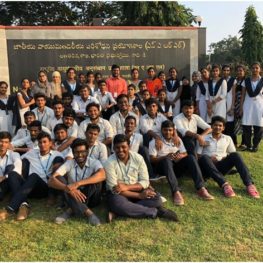Start
End
Report on NATIONAL ATMOSPHERIC RESEARCH LABORATORY (NARL)
III Year ECE53 students of GIST-Nellore have visited NARL on 09-11-2018., accompanied by faculty members Mr. G. Kiran Kumar, Ms. Sk. Shahina and Mrs. Y. Rajitha. The National Atmospheric Research Laboratory (NARL) is an autonomous Research Institute funded by the Department of Space of the Government of India. NARL is engaged in fundamental and applied research in the field of Atmospheric Sciences. The research institute was started in 1992 as National Mesosphere-Stratosphere-Troposphere (MST) Radar Facility (NMRF). Over the years many other facilities such as Mie/Rayleigh Lidar, Lower atmospheric wind profiler, optical rain gauge, disdrometer, automated weather stations etc. were added. The NMRF was then expanded into a research institute and renamed as National Atmospheric Research Laboratory on 22 September 2005.
The entire team is guided by Dr.K.Rajendra Prasad, Scientist/ Engineer – SE , who also made a presentational talk about NARL and different projects and departments involved in NARL for an hour. A spectacular view of NARL campus from the conference hall terrace is observed.
Around 2.00 PM, interior visit of NARL has started. Firstly, the Data base management system of centre which carries all the information regarding projects carried out in NARL, has been visited. Special servers which cannot be authorized by hackers, Super Computers, tertiary Data Storage Devices like Magnetic Tapes and the process of data dissemination are explained by the technical guides present there.
Atmospheric research centre management system, which is currently using the high performance computers with an architecture of SNAS (Scalable network Attached storage) which gives high performance in computing the large data tasks whose data exchange rate is of 40 GB/s is visited.
At 2.40 PM, Atmospheric Wind Profiling Radar, which was inaugurated on 7th March 2010 by Dr. K. Kasthurirangan, is visited. Technical explanation on GPS Radiosonde System is presented by the guide. Here they implemented a new technique to generate the daily weather report with the help of GPS Sonde attached with strip antenna which is connected to the Parachutes. The GPS antenna transmits the information from the balloon and it gets received to the GPS Sonde receiver. Usually, they conduct this experiment in the zero-th hour regularly i.e., 5.30 PM
At 3.00 PM, Lidar research centre is visited. It involves the beam of light using two mirrors for reflecting the light into atmosphere. The reflected light rays are received by telescopes to measure the different conditions of weather during day time.
The tour ends after visiting the MST radar station which requires 1024 antenna arrays to conduct front line research in atmospheric conditions.






